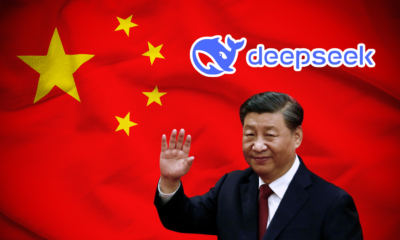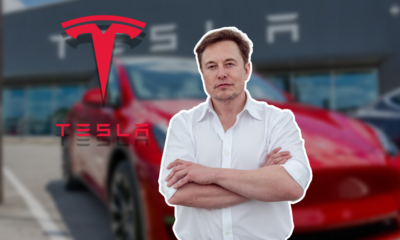Tech
Who’s Really Winning The AI Race 2 Years After ChatGPT’s Debut? Hint: It’s Not Nvidia. The AI Race, Why It Matters?
Published
11 months agoon

Since ChatGPT’s debut in November 2022, AI has redefined markets, rocketed tech stocks to spectacular highs, and turned Nvidia into a household name as the AI-chip giant. However, the most surprising winner in this AI gold rush isn’t Nvidia, nor any of the usual tech behemoths.
Instead, it’s a lesser-known player from Ohio: Vertiv Holdings, a cooling technology company that’s quietly outperformed nearly everyone.
From Chatbots to Cooling Giants
Vertiv’s journey from obscurity to AI darling status is a case study in being at the right place at the right time.
As demand for large language models and sprawling data centers surged, Vertiv’s expertise in cooling solutions became indispensable. Data centers—hot, power-hungry nerve centers of the AI boom—need robust infrastructure to keep them running efficiently.
Enter Vertiv, whose stock has skyrocketed 861% since ChatGPT’s launch. In 2023 alone, Vertiv’s shares surged 165%, and its market size has more than tripled in 2024.
David Cote, Vertiv’s CEO, is optimistic: “We believe we are in a very strong position to enjoy the benefits AI is driving to the entire data center industry. We’re a leader in data center infrastructure, and I’m very optimistic about the future.”
Nvidia. The Iconic Runner-Up
Nvidia, synonymous with AI’s rise, has seen a 722% increase in its stock over the same period. Its powerful GPUs are the backbone of AI’s large language models, making it a critical player in the industry. Yet, even as Nvidia enjoys its tech titan status, its massive gains haven’t quite matched Vertiv’s phenomenal trajectory.
Other Contenders
Beyond these two, other tech stocks have seen notable growth:
- Advanced Micro Devices (AMD) surged 90%, though it’s down 4% in 2024.
- Broadcom climbed 208% since ChatGPT’s launch and is up 50% this year.
Meanwhile, Intel has struggled, with shares down 19%, proving not all tech companies are riding the AI wave successfully.
Even lesser-known companies like Modine Manufacturing have become AI beneficiaries, with their air cooling stock advancing 550% in two years, more than doubling in 2024.
The Magnificent Seven and AI’s Spending Surge
The so-called “Magnificent Seven” tech giants—Nvidia, Microsoft, Apple, Tesla, Meta, Amazon, and Alphabet—have collectively soared 203% in two years. Semiconductor stocks have also risen 77%, driven by the AI boom, while capital spending on AI has outpaced the S&P 500 by a staggering 230%.
What’s clear from Vertiv’s success is that the AI race isn’t just about flashy new tech or cutting-edge algorithms—it’s also about the underlying infrastructure. Companies that build, power, and cool data centers are emerging as the unsung heroes of AI’s meteoric rise.

Why The AI Race Matters And Who Really Are The Winners?
Choosing a “winner” in the AI race depends on which aspect of the competition you’re focusing on. Each player has strengths in different areas, making this race less about a single victor and more about a dynamic ecosystem where multiple winners can coexist.
Let’s break down where the major players stand in this multi-faceted race-
1. Model Development. The Race for the Smartest AI
A) OpenAI
Two years after ChatGPT’s debut, OpenAI remains the face of AI innovation. With around $22 billion in funding, OpenAI transitioned from a cautious nonprofit to a global tech powerhouse. Yet, its dominance is being questioned.
Strengths: GPT-4 remains a benchmark, but with no new major model expected until 2025, competitors are closing in. However, OpenAI’s innovations, like its “reasoning” model o1 and advanced voice capabilities, keep it at the forefront.
Challenges: The pace of innovation has slowed, raising concerns about whether its next big leap will be as transformative.
B) Anthropic
Founded by ex-OpenAI employees, Anthropic has embraced a cautious yet competitive approach. With $14 billion in funding and recent backing from Amazon and Google’s Alphabet, it’s becoming a serious contender.
Strengths: Anthropic’s Claude 3.5 Sonnet has been praised as a rival to GPT-4, with some even suggesting it surpasses OpenAI’s model in specific tasks.
Challenges: Despite strong models, Anthropic’s user base is much smaller, though partnerships with firms seeking alternatives to Microsoft offer growth potential.
C) Google
Google’s early AI research laid the groundwork for today’s generative AI, but ChatGPT’s rapid rise left Google scrambling.
Strengths: Its Gemini AI model stands toe-to-toe with OpenAI and Anthropic.
Challenges: Developer adoption has been slower, and despite its vast resources, Google has struggled to regain its footing amid fierce competition.
2. Customer Adoption
A) OpenAI
With over 200 million weekly active users of ChatGPT and a deep integration with Microsoft’s ecosystem, OpenAI enjoys a vast direct and indirect customer base.
Advantage: Its collaboration with Microsoft ensures its AI reaches millions through platforms like Microsoft 365 and Azure.
B) Anthropic
While smaller in scale, Anthropic is gaining ground by positioning itself as a counterbalance to Microsoft’s dominance.
Advantage: Partnerships with mid-sized and large firms provide an opening for Anthropic to expand beyond niche markets.
C) Google
Google leverages its massive reach by embedding AI into its products, from search results to Android devices.
Advantage: Its existing global user base ensures that its AI tools are seen by millions daily.
3. Infrastructure. The Backbone of AI Expansion
A) OpenAI
Highly dependent on Microsoft’s cloud services, OpenAI is working to diversify its partnerships to ensure long-term scalability.
B) Anthropic
With Amazon’s $4 billion investment and support from Alphabet, Anthropic is well-positioned in the cloud race, giving it access to substantial computing power.
C) Google
Google’s deep expertise in infrastructure should be a major advantage, but the company has been slow to capitalize fully on its strengths. The frantic pace of AI development has kept it off-balance, even though its capabilities remain world-class.

Meta’s Bold Move in the AI Race
When it comes to AI, Meta has taken a distinctive approach by championing open-source AI through its Llama models. This strategy serves as both a competitive edge and a hedge against the dependency traps of the past, like its reliance on Apple and Google in the smartphone era.
Let’s look into how Meta and other players are positioning themselves in this fierce AI race.
Meta’s Strategy. Open-Source Freedom and Integration
Models- Scaling Smart, Not Big
Unlike OpenAI’s large-scale, proprietary models, Meta’s Llama models focus on delivering better performance at smaller scales. The open-source approach gives businesses the freedom to adapt and cost savings, which are becoming increasingly attractive in a market dominated by expensive AI services.
Customer Base- A Built-in Audience of Billions
With over 3 billion users across Facebook, Instagram, WhatsApp, and Messenger, Meta has an unparalleled reach. Llama’s adaptability and low cost are likely to attract business customers looking for customizable AI solutions without hefty price tags.
Meta’s Meta AI chatbot is already reshaping user experiences across its platforms, from Messenger and WhatsApp to Instagram’s search function and even the AI-powered assistant on Meta’s Ray-Ban smart glasses.
Infrastructure- Scaling with Experience, Not Cloud Dominance
Although Meta doesn’t offer a B2B cloud service like Microsoft or Amazon, it has extensive experience in scaling data centers for its global social media platforms. This expertise gives Meta a strong backbone to support AI advancements internally and externally.
Other Key Players in the AI Race
Microsoft – Microsoft’s partnership with OpenAI is deep, but it’s also hedging its bets by developing in-house models under the leadership of Mustafa Suleyman, co-founder of DeepMind. This dual strategy could make Microsoft a major player both as a partner and a competitor in AI.
Amazon – Amazon continues to dominate the cloud infrastructure space, providing the backbone for AI’s exponential growth. Meanwhile, its own AI models are quietly evolving, positioning Amazon as both a cloud provider and a future AI contender.
xAI (Elon Musk’s Venture) – With over $11 billion raised and claims of building the world’s largest AI data center, xAI is making bold promises. However, its strategy remains unclear beyond vague notions of freedom of speech and data sovereignty. Musk’s involvement ensures attention, but concrete plans are still awaited.
Apple – Apple is playing catch-up, integrating Apple Intelligence into iOS and macOS while revamping Siri. Although late to the race, Apple’s reputation for seamless integration and user privacy could give it a unique edge as AI becomes more embedded in daily life.
The Hidden Battleground. Data
AI’s future depends heavily on access to vast datasets, and tech giants have long been stockpiling this invaluable resource. However, several hurdles are emerging:
Copyright laws: Legal battles over the use of copyrighted content for AI training could limit data availability.
Public distrust: Skepticism from creators and the public is rising as AI systems become more intrusive.
Privacy commitments: Companies that have pledged strong privacy protections may face difficulties balancing data needs with ethical obligations.

The one prominent company that surprisingly doesn’t feature in this list is Intel and Intel’s struggle in the AI race can be attributed to several prominent factors-
1. Missed Early-Mover Advantage in AI Hardware
While companies like Nvidia and AMD were quick to position their GPUs for AI applications, Intel remained focused on traditional CPUs. GPUs are more efficient for AI workloads, such as training large language models, giving Nvidia a head start in dominating the AI chip market.
2. Delays in Innovation
Intel has faced delays in rolling out advanced semiconductor technologies, especially its transition to smaller, more efficient manufacturing nodes. Competitors like TSMC and AMD have been quicker to adopt cutting-edge processes, giving them a competitive edge in performance and energy efficiency.
3. Acquisition Missteps
Intel acquired Habana Labs in 2019 and launched its AI-focused Gaudi chips, but the impact has been muted compared to Nvidia’s GPUs. Intel’s acquisitions haven’t translated into a market-leading AI presence, while Nvidia’s CUDA platform has become the gold standard for AI developers.
4. Limited Ecosystem Integration
Nvidia and AMD have successfully cultivated strong ecosystems that integrate hardware, software, and developer tools, making them attractive to AI researchers and enterprises. Intel has struggled to build a similarly cohesive ecosystem, limiting its appeal in AI-driven markets.
5. Underperformance in Data Center Solutions
While companies like Vertiv and Modine have capitalized on data center infrastructure demand, Intel has not significantly expanded its presence in AI-specific data center solutions. This limited its ability to capture value from the broader AI-driven infrastructure boom.
6. Investor Confidence and Market Perception
Intel’s stock performance reflects a broader perception that it’s lagging behind in innovation and execution compared to its peers. Investor sentiment has favored companies that are aggressively pursuing AI-related opportunities, while Intel’s cautious approach has hurt its market value.

A Race with No Single Winner
Meta’s open-source strategy, Microsoft’s dual approach, Amazon’s cloud dominance, xAI’s bold ambitions, and Apple’s steady integration all highlight the diverse ways companies are tackling the AI challenge.
While the race is far from over, it’s clear that success will come in many forms—from technological breakthroughs to innovative business models and ethical leadership. In this multifaceted competition, there may be more than one way to win.
Hence, while many leading AI companies have committed to developing Artificial General Intelligence (AGI)—a level of AI that matches or surpasses human intelligence. However, defining AGI is subjective, with each company setting different benchmarks for success. This makes the race for AGI less about reaching a universally recognized milestone and more about who can define and demonstrate it first.
You may like
-


Modi’s Ideal Deal With Tesla To Produce Cars In India—But Will And More Importantly Can Tesla Take That Chance?
-


DeepSeek Ai Rush. China’s AI Contender Gears Up for Next Big Launch Even As It Gets Xi Jinping’s Blessings
-


Salvaging The $44 Billion Investment In X. Winds Of Change For Musk Amid His ‘Fix’ Mission Over High Support For Zelenskyy On X
-


After A Tough Year In China, And Plummeting Sales, Can Tesla’s India Gamble Steer It Back On Track Amid Musk’s Controversies?
-


Layoffs Are Back. JPMorgan, Chevron, And More—Why Across All Sectors Nearly Half Of Companies Expect Job Cuts In 2025?
-


Elon Musk’s Bold Bet, Big Win As Amazon Returns, Sues Other Major Brands Over Ad Boycott. Can Legal Action Revive X’s Ad Revenue?

